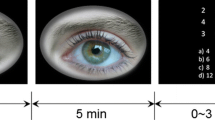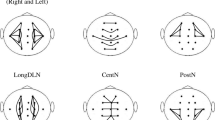Abstract
Tasks with high mental workload often involve higher cognitive functions of the human brain and complex information flow involving multiple brain regions. However, the dynamics of functional connectivity between brain regions during high mental workload have not been well-studied. We use an analysis approach designed to find repeating network states from gamma-band phase locking value networks built from electroencephalograph data collected while participants engaged in tasks with different levels of mental workload. First, we define network states as results of clustering based on the closeness centrality node-level network metric. Second, we found that the transition between network states is not completely random. And, we found significant differences in network state statistics between low and high mental workload. Third, we found significant correlation between features calculated from the network state sequence and behavioral performance. Finally, we use dynamic network features as input to a support vector machine classifier and obtain cross-participant average decoding accuracy of 69.6%. Our methods provide a new perspective for analyzing the dynamics of electroencephalograph signals and have potential application to the decoding of mental workload level.









Similar content being viewed by others
Data availability
Data will be made available on reasonable request.
Code availability
Code will be made available on reasonable request.
References
Ahonen V, Leino M, Lipping T (2021) Electroencephalography in evaluating mental workload of gaming. In: 2021 43rd annual international conference of the IEEE engineering in medicine & biology society (EMBC). IEEE, pp 845–848
Appel T, Gerjets P, Hoffman S et al (2023) Cross-task and cross-participant classification of cognitive load in an emergency simulation game. IEEE Trans Affect Comput 14(2):1558–1571
Arthur D, Vassilvitskii S (2007) K-means++ the advantages of careful seeding. In: Proceedings of the eighteenth annual ACM-SIAM symposium on discrete algorithms, pp 1027–1035
Borghini G, Astolfi L, Vecchiato G et al. (2014) Measuring neurophysiological signals in aircraft pilots and car drivers for the assessment of mental workload, fatigue and drowsiness. Neurosci Biobehav Rev 44:58–75
Brouwer AM, Hogervorst MA, Van Erp JB et al. (2012) Estimating workload using EEG spectral power and ERPs in the n-back task. J Neural Eng 9(4):045008
Carlson S, Martinkauppi S, Rämä P et al. (1998) Distribution of cortical activation during visuospatial n-back tasks as revealed by functional magnetic resonance imaging. Cereb Cortex (New York, NY: 1991) 8(8):743–752
Chang C, Liu Z, Chen MC et al. (2013) EEG correlates of time-varying bold functional connectivity. Neuroimage 72:227–236
Dai Z, De Souza J, Lim J et al. (2017) Eeg cortical connectivity analysis of working memory reveals topological reorganization in theta and alpha bands. Front Hum Neurosci 11:237
Demir S, Türker İ (2021) Arithmetic success and gender-based characterization of brain connectivity across EEG bands. Biomed Signal Process Control 64(102):222
Dimitrakopoulos GN, Kakkos I, Dai Z et al. (2017) Task-independent mental workload classification based upon common multiband EEG cortical connectivity. IEEE Trans Neural Syst Rehabil Eng 25(11):1940–1949
Dimitrakopoulos GN, Kakkos I, Anastasiou A et al. (2023) Cognitive reorganization due to mental workload: A functional connectivity analysis based on working memory paradigms. Appl Sci 13(4):2129
Dunn JC (1974) Well-separated clusters and optimal fuzzy partitions. J Cybern 4(1):95–104
Dussault C, Jouanin JC, Philippe M et al. (2005) EEG and ECG changes during simulator operation reflect mental workload and vigilance. Aviat Space Environ Med 76(4):344–351
Greicius MD, Krasnow B, Reiss AL et al. (2003) Functional connectivity in the resting brain: a network analysis of the default mode hypothesis. Proc Natl Acad Sci 100(1):253–258
Guan K, Zhang Z, Chai X et al. (2022) Eeg based dynamic functional connectivity analysis in mental workload tasks with different types of information. IEEE Trans Neural Syst Rehabil Eng 30:632–642
Herrera-Díaz A, Mendoza-Quiñones R, Melie-Garcia L et al. (2016) Functional connectivity and quantitative EEG in women with alcohol use disorders: a resting-state study. Brain Topogr 29:368–381
Hoedemaeker M (2002) Summary description of workload indicators: Wp1 workload measures. Human machine interface and the safety of traffic in Europe growth project. Technical report, GRD1-2000-25361. HASTE. Institute for Transport Studies. Leeds, UK
Ismail LE, Karwowski W (2020) A graph theory-based modeling of functional brain connectivity based on EEG: a systematic review in the context of neuroergonomics. IEEE Access 8:155103–155135
Jian W, Chen M, McFarland DJ (2017) EEG based zero-phase phase-locking value (PLV) and effects of spatial filtering during actual movement. Brain Res Bull 130:156–164
Kakkos I, Dimitrakopoulos GN, Gao L et al. (2019) Mental workload drives different reorganizations of functional cortical connectivity between 2d and 3d simulated flight experiments. IEEE Trans Neural Syst Rehabil Eng 27(9):1704–1713
Kaposzta Z, Stylianou O, Mukli P et al. (2021) Decreased connection density and modularity of functional brain networks during n-back working memory paradigm. Brain Behav 11(1):e01932
Khanna A, Pascual-Leone A, Michel CM et al. (2015) Microstates in resting-state EEG: current status and future directions. Neurosci Biobehav Rev 49:105–113
Langer N, Von Bastian CC, Wirz H et al. (2013) The effects of working memory training on functional brain network efficiency. Cortex 49(9):2424–2438
Lehmann D, Faber PL, Galderisi S et al. (2005) EEG microstate duration and syntax in acute, medication-naive, first-episode schizophrenia: a multi-center study. Psychiatry Res Neuroimaging 138(2):141–156
Li D, Wang X, Menassa CC et al. (2020) In: Start-up creation (Second Edition), second, edition. Woodhead Publishing Series in Civil and Structural Engineering, Woodhead Publishing, pp 291–341
Li KW, Lu Y, Li N (2022) Subjective and objective assessments of mental workload for UAV operations. Work 72(1):291–301
Liu Z, Si L, Xu W et al. (2022) Characteristics of EEG microstate sequences during propofol-induced alterations of brain consciousness states. IEEE Trans Neural Syst Rehabil Eng 30:1631–1641
Mishra B, Tarai S, Ratre V et al (2023) Processing of attentional and emotional stimuli depends on retrospective response of foot pressure: conceptualizing neuron-cognitive distribution in human brain. Comput Biol Med 164:107186
Newman ME, Barabási ALE, Watts DJ (2006) The structure and dynamics of networks. Princeton University Press, Princeton
Núñez P, Poza J, Gómez C et al. (2021) Abnormal meta-state activation of dynamic brain networks across the Alzheimer spectrum. Neuroimage 232(117):898
Oldham S, Fulcher B, Parkes L et al. (2019) Consistency and differences between centrality measures across distinct classes of networks. PloS One 14(7):e0220061
Palva JM, Monto S, Kulashekhar S et al. (2010) Neuronal synchrony reveals working memory networks and predicts individual memory capacity. Proc Natl Acad Sci 107(16):7580–7585
Popov T, Popova P, Harkotte M et al. (2018) Cross-frequency interactions between frontal theta and posterior alpha control mechanisms foster working memory. Neuroimage 181:728–733
Prasad R, Tarai S, Bit A (2022) Investigation of frequency components embedded in EEG recordings underlying neuronal mechanism of cognitive control and attentional functions. Cogn Neurodyn 1–24
Raichle ME, MacLeod AM, Snyder AZ et al. (2001) A default mode of brain function. Proc Natl Acad Sci 98(2):676–682
Ren S, Li J, Taya F et al. (2016) Dynamic functional segregation and integration in human brain network during complex tasks. IEEE Trans Neural Syst Rehabil Eng 25(6):547–556
Roy RN, Bonnet S, Charbonnier S et al. (2016) Efficient workload classification based on ignored auditory probes: a proof of concept. Front Hum Neurosci 10:519
Rubinov M, Sporns O (2010) Complex network measures of brain connectivity: uses and interpretations. Neuroimage 52(3):1059–1069
Rubio S, Díaz E, Martín J et al. (2004) Evaluation of subjective mental workload: a comparison of swat, NASA-TLX, and workload profile methods. Appl Psychol 53(1):61–86
Shaw JB, Weekley JA (1985) The effects of objective work-load variations of psychological strain and post-work-load performance. J Manag 11(1):87–98
Shi W, Li Y, Liu Z et al. (2020) Non-canonical microstate becomes salient in high density EEG during propofol-induced altered states of consciousness. Int J Neural Syst 30(02):2050005
So WK, Wong SW, Mak JN et al. (2017) An evaluation of mental workload with frontal EEG. PloS One 12(4):e0174949
Stam CJ, Nolte G, Daffertshofer A (2007) Phase lag index: assessment of functional connectivity from multi channel EEG and meg with diminished bias from common sources. Hum Brain Mapp 28(11):1178–1193
Tang S, Liu C, Zhang Q et al. (2021) Mental workload classification based on ignored auditory probes and spatial covariance. J Neural Eng 18(4):0460c9
Tarai S, Qurratul QA, Ratre V et al. (2022) Neurocognitive functions of prosocial and unsocial incongruency information during language comprehension: evidence from time-frequency analysis of EEG signals. Med Biol Eng Comput 60(4):1033–1053
Tukey JW et al. (1977) Exploratory data analysis, vol 2. Reading, MA
Vidaurre C, Blankertz B (2010) Towards a cure for BCI illiteracy. Brain Topogr 23:194–198
Vidaurre D, Smith SM, Woolrich MW (2017) Brain network dynamics are hierarchically organized in time. Proc Natl Acad Sci 114(48):12827–12832
Vidaurre D, Hunt LT, Quinn AJ et al. (2018) Spontaneous cortical activity transiently organises into frequency specific phase-coupling networks. Nat Commun 9(1):2987
Villaret M, et al. (2021) Mental workload detection based on EEG analysis. In: A: artificial intelligence research and development: proceedings of the 23rd international conference of the catalan Association for Artificial Intelligence
Wilson GF (2005) Operator functional state assessment for adaptive automation implementation. In: Biomonitoring for physiological and cognitive performance during military operations. SPIE, pp 100–104
Xu Z, Tang S, Liu C et al. (2023) Temporal segmentation of EEG based on functional connectivity network structure. Sci Rep 13(1):22566
Zhang P, Wang X, Zhang W et al. (2018) Learning spatial-spectral-temporal EEG features with recurrent 3d convolutional neural networks for cross-task mental workload assessment. IEEE Trans Neural Syst Rehabil Eng 27(1):31–42
Zhang Y, Yan G, Chang W et al. (2023) EEG-based multi-frequency band functional connectivity analysis and the application of spatio-temporal features in emotion recognition. Biomed Signal Process Control 79(104):157
Zhou T, Kang J, Li Z et al. (2020) Transcranial direct current stimulation modulates brain functional connectivity in autism. NeuroImage Clin 28:102500
Acknowledgements
The authors would like to thank Yiming Ding and Yuanxiang Jiang for their useful discussions and the reviewers for their constructive feedback.
Funding
This work was supported in part by the STI 2030-Major Projects of the Ministry of Science and Technology of China (2021ZD0200407), the National Key Research and Development Program of China (2020YFC0832402), and the Innovation Team Project of Guangdong Provincial Department of Education (2021KCXTD014).
Author information
Authors and Affiliations
Corresponding author
Ethics declarations
Conflict of interest
The authors declare that they have no Conflict of interest.
Ethics approval
The studies involving human participants were reviewed and approved by the institutional human research ethics review committee of the State Key Laboratory of Neuroscience and Learning at Beijing Normal University (ID number: CNL_A_0010_002, approval date November, 2019). The participants provided their written informed consent to participate in this study.
Additional information
Publisher's Note
Springer Nature remains neutral with regard to jurisdictional claims in published maps and institutional affiliations.
Supplementary Information
Below is the link to the electronic supplementary material.
Rights and permissions
Springer Nature or its licensor (e.g. a society or other partner) holds exclusive rights to this article under a publishing agreement with the author(s) or other rightsholder(s); author self-archiving of the accepted manuscript version of this article is solely governed by the terms of such publishing agreement and applicable law.
About this article
Cite this article
Xu, Z., Huang, J., Liu, C. et al. Dynamic functional connectivity correlates of mental workload. Cogn Neurodyn (2024). https://doi.org/10.1007/s11571-024-10101-4
Received:
Revised:
Accepted:
Published:
DOI: https://doi.org/10.1007/s11571-024-10101-4




